Over the last 5 years
there has been an explosion of ragwort in the UK. One can hardly
avoid seeing it along road verges and in central reservations
of motorways. However, animals seldom graze these areas and
so many lay people driving along comment on how pretty the flowers
are in high summer and how the fluffy seeds can be seen to blow
away in the wind - giving the impression of a dandelion clock!
The yellow peril is lurking and expanding its grip on the UK
- it presents a serious hazard for horses and other grazing
animals.
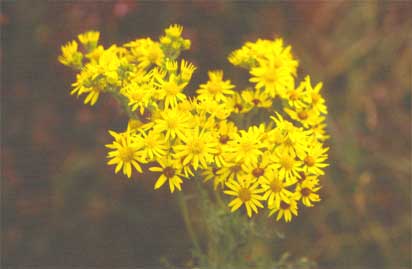
Ragwort in full bloom
The potential danger
of ragwort has been known for many years - indeed the plant
was classified as a noxious weed in terms of the Act and as
such every owner of land was required to control ragwort either
by direct spraying or by lifting and burning it. Up to the last
5 years the value of this policy was widely appreciated by farmers
and horse owners alike. It was rare to see any ragwort growing
anywhere and prosecutions were rarely needed. There has been
a clear change in policy over the weed. Now a landowner on whose
land ragwort is growing can only be prosecuted if it can be
proven that by allowing the plant to proliferate on his land
someone else's animals are proven to have suffered. This is
nonsense of course because it is quite clearly impossible for
an owner of a ragwort-poisoned horse to be sure within the law
that the problem arose from one source! Imagine trying to sue
the Ministry of Transport because they have allowed ragwort
to grow on the central reservation of a motorway.
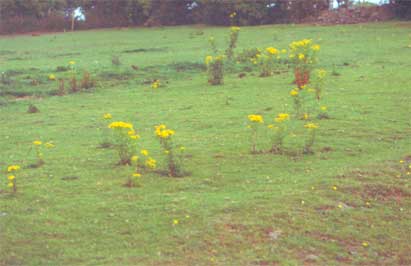
A field covered in Ragwort
Interestingly some
areas of the UK have very progressive and caring local authorities
and they are clearly taking action against the scourge. Every
now and again you will find swathes of ragwort free roads and
fields! By contrast you will certainly see whole areas of the
country where nothing is done to control it at all. Meadows
of lovely yellow flowers and deep green florets can be attractive
to the uninformed passer-by! We all know it is a time bomb waiting
to explode (in our horses!).
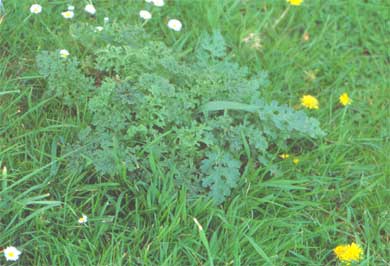
The florets of the Ragwort Plant
Do horses actually
eat it?
For many years it
has been assumed that horses will not eat green growing ragwort
plants but this is far from proven. Indeed it is only based
on supposition that when horses are grazing in a field in mid
summer the ragwort appears to be untouched.
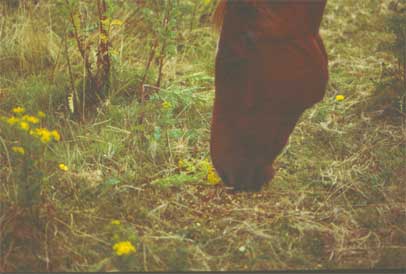
Grazing near Ragwort

A horse grazing a Ragwort infested
field
This is a very simplistic
approach and it is impossible to know categorically that the
horses are never even tempted to take a mouthful. The biggest
difficulty lies in the palatability of the plant. In its green
growing state it is probably fairly unpalatable but the wilted
or cut and dried plant is not detected at all. Thus hay that
has been cut from a field with ragwort will be potentially lethal.
The repeated ingestion of a small amount is probably the worst
possible scenario!
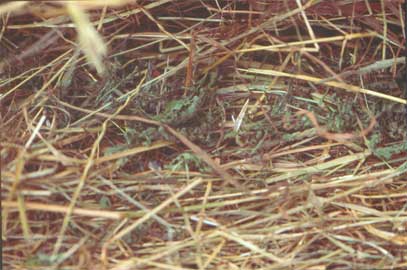
Ragwort in Hay

Ragwort in Haylage
As the plant is most
palatable in dried or preserved forage the greatest risk appears
to come from the winter feeding! How many of us know if the
hay or haylage we use is certainly ragwort free? It is unlikely
that any meadow hay is totally free of ragwort in the UK. This
means that damage can be occurring in the horse over the winter
without any sign! It is a time bomb quietly ticking away! This
probably explains why we see cases of ragwort poisoning in the
late spring and early summer.
What does it do
to the horse?
Ingestion of the
ragwort plant (in any state in any amount) will result in the
absorption of the pyrrolizidine alkaloid that passes to the
liver in the portal blood vessels. On arrival the toxin damages
the liver cells to an extent that is proportional to the concentration
of the chemical. As the blood is delivered to the liver in the
portal vessels the changes are very characteristic. Pathologists
can easily detect the changes and can be reasonably certain
that they are caused by ragwort. However, the diagnosis would
relay on biopsy and this is not an easy procedure and is certainly
invasive. Repeated and sustained ingestion (or the ingestion
of a large amount) of ragwort causes progressive fibrosis and
shrinking of the liver. Once more than 75% of the organ is damaged
irreparably the horse will show the characteristic clinical
signs. These include lethargy, weight loss, diarrhoea or at
least pasty sloppy faeces, and in the summer months photosensitisation.
Photosensitisation
occurs because the liver is badly damaged and therefore fails
to remove plant pigments that then are allowed to circulate
in the blood. These are deposited in the white skinned areas
and when the sun shines on this skin it causes massive destruction
and release of bioactive inflammatory mediators that are associated
with serious skin damage. The pigmented skin is not usually
affected.
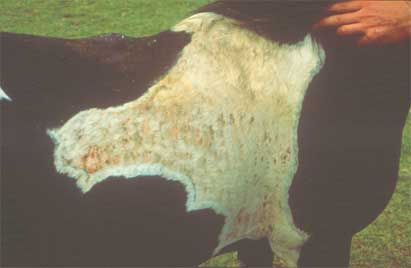
The effects of Photosensitisation
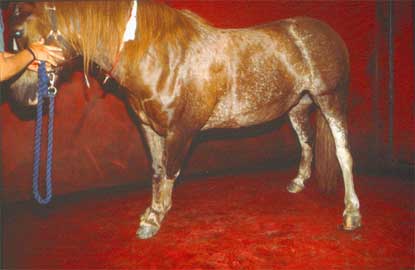
The
effects of Hepatoencephalopathy
Perhaps the most
dramatic sign of hepatic failure is hepatoencephalopathy. Here
chemicals (and in particular ammonia) that should be removed
from the blood by the liver poison the central nervous system.
Progressive accumulation of these chemicals results in serious
brain disease, which shows as depression, abnormal behaviour
(either mania or convulsions and seizures) and sometimes even
blindness.
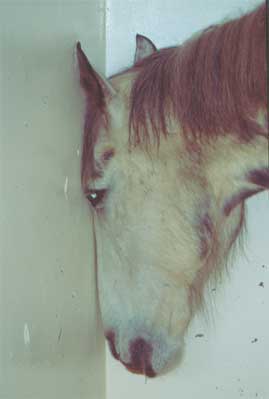
More effects of hepatoencephalopathy
At this stage the
horse is probably beyond treatment but just occasionally we
can save them at least temporarily. The clinical entity is a
very distressing condition for both horse and owner and indeed
many horses hurt themselves and / or hurt the owner.
How can we diagnose
the problem?
The biggest problem
with ragwort is that it is extremely poisonous to horses in
particular and somewhat less so to ruminants. Even small amounts
cause significant liver damage. It is easy to ask then why we
do not see plenty of cases every year! The reason is that the
liver has an enormous functional reserve (over 75%). Clinical
signs of liver disease only appear when there is less than 25%
of the functional tissue left! This can be some years later
and although the liver can repair itself to some extent it is
also known that the pyrrolizidine alkaloid poison inhibits the
repair mechanisms. Therefore repeated ingestion of even small
amounts is potentially very dangerous. The signs may only appear
some years later when the liver is beyond repair and beyond
treatment.
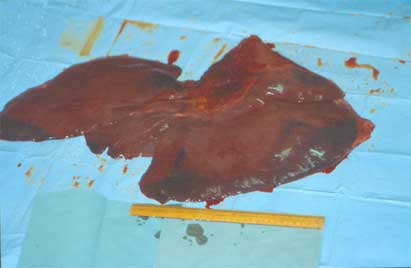
The effects of Ragwort on the Horses' liver
While the mildest
signs of liver damage are not usually detectable from the outside,
damage to liver cells can be detected by blood samples. The
acute (fresh) damage to liver cells causes leakage of enzymes
from the cells into the blood stream. These enzymes should not
normally be present in abnormal amounts and so detection of
elevated enzyme concentrations in the blood is highly suggestive
of liver cell damage. Also as the liver becomes more and more
damaged the functional reserve is gradually eroded until it
can no longer cope with all the tasks it is required to do.
Then some signs of liver disease become apparent.
Recently it has become
possible to detect the alkaloid in the blood of horses at a
very minute concentration! Of course any of the chemical indicates
that the horse is eating ragwort and the food can be changed
to a better type! Unfortunately this test is not yet available
but we hope this year to get it running on a preliminary trial.
We would then expect that a proportion of the horses in a yard
would be blood tested every month or two and if no alkaloid
was present then the feeding could reasonably be expected to
be safe (with respect of course only to ragwort!) If you are
interested in helping us to develop the test please contact
me. We need financial support for this project and we need owners
and vets who will take part in the trial phase at first!
Can it be treated?
Liver failure cannot
be treated - it can only be assisted to repair itself. Therefore
once the clinical signs appear it means that there is no reserve
of liver and that recovery is virtually impossible. Over the
last few years there have been cases that have been suspected
as being Ragwort-related liver failure that have recovered from
a serious state. Of course a few cases that have limited damage
do recover but if Ragwort toxins extensively damage the liver
then it will not repair effectively. Most of the cases that
are diagnosed at an early stage can recover sufficiently to
have a useful life but of course many cases with other forms
of liver disease are diagnosed as being Ragwort poisoning. There
are other types of liver damage including acute and chronic
hepatitis that can be treated and that hold out a much improved
prognosis.
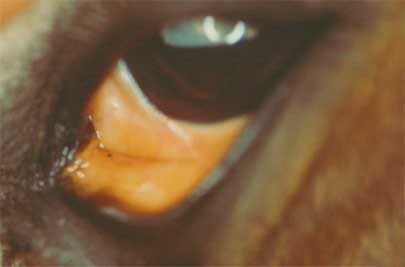
Signs of Liver damage
For the most part
terminal Ragwort damage results in a wide variety of signs and
each of the deficient functions needs to be supported by medications
and management. For example because the liver makes clotting
factors for the blood, these need to be replaced in horses with
serious terminal liver failure. Similarly the protein metabolism
is impaired and so plasma transfusions may be helpful. It is
important that the attending vet knows the full range of signs
that are being shown and then suitable measures can be used
to treat each of these directly. Cases showing neurological
signs (blindness, aimless wandering, seizures and collapse often
need sedation to prevent themselves from self-injury. Throughout
the management of the Ragwort poisoned horse the over-riding
sentiment must be for the welfare of the animal. Most cases
are destroyed on humane grounds as soon as the diagnosis is
confirmed.
The untreatable nature
of terminal Ragwort poisoning merely serves to illustrate the
importance of an accurate diagnosis even at this stage. It would
be far better of course to detect the poison long before the
extent of the damage is irretrievable. This is why we need to
eliminate Ragwort from the UK - the reality is that it is here
to stay - we have largely lost the battle and we can expect
many more cases of fatal hepatic disease in our horses. If we
have to accept that it is going to be around for some years
yet then we need to identify whether individual horses are eating
any of it - even one molecule of the toxin causes damage. A
blood test would identify if the food contains any Ragwort and
then at least there would be a chance to change the feed and
avoid progression of the disease. Finding Ragwort in hay or
haylage is very difficult task and not many of us has time to
carefully sift through every hay net of food to ensure it is
safe.
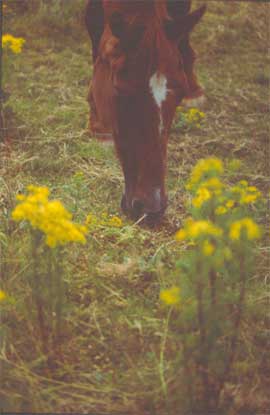
The danger of Ragwort
I am not sure that
any pasture in UK can now be guaranteed to be free of the plant
and this is a terrible indictment of our care for the countryside
over the last 5 - 10 years.
Derek
C Knottenbelt BVM&S, DVM&S,
MRCVS